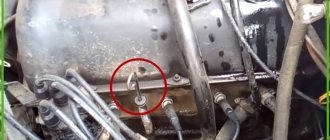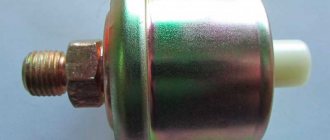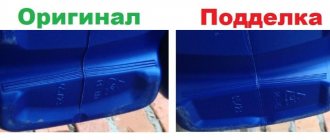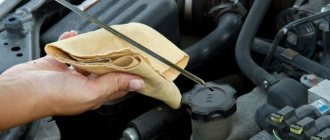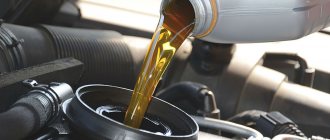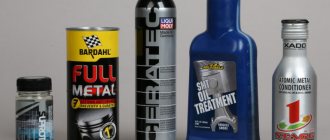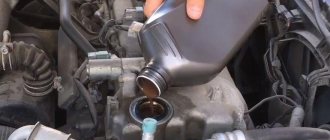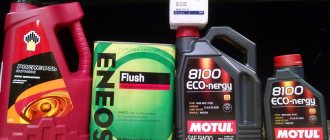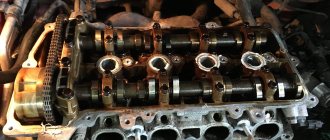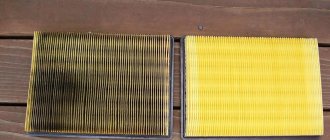Today we will look at an interesting question - what additives can be used to increase oil pressure in the engine? Over time, every owner of his car is faced with the fact that the engine in his car begins to wear out, gradually using up its engine life. At this time, first minor and then quite serious problems with the engine begin to occur en masse. One of these negative symptoms of the condition of the unit is problems with engine oil pressure.
And here the car owner becomes faced with a dilemma: should he carry out a major overhaul of the unit or postpone this moment for a while?
If a motorist does not have the necessary amount to repair the engine or he does not have enough time for this, then there is only one way out - to extend the engine’s performance for some time using various additives.
The main causes of low engine oil pressure
Reduced engine oil pressure in the engine can be caused by the following reasons:
- The engine was filled with low-viscosity engine oil that was not suitable for long-term use. A product of this quality in most cases is a fake of poor quality.
- Engine wear, which manifests itself in increased gaps between the bearings and the engine crankpins.
- Wear of the internal surface of the pump and, in connection with this, the inability of such a pump to create the necessary engine oil pressure.
- Significant wear of the cylinder-piston sector, where significant gaps appear between the piston and cylinder. In view of this, oil flows from the walls at a higher speed, which leads to a decrease in oil pressure.
What to do if oil pressure drops to critical levels
For most vehicles, an illuminated oil can indicator on the instrument panel indicates insufficient lubricant pressure. If the light goes out after a few seconds, you must monitor it closely throughout the route. Most often, such symptoms appear in winter, especially when the car starts cold. The indication appears when the vehicle rolls heavily when turning.
If the indication is constant, you must contact a service center and stop using the vehicle. A critically low fluid level indicates insufficient oil in the crankcase. The driver needs to check the level with a special dipstick and, if necessary, add a similar composition. In most cases, this measure is enough for the indication to disappear. You will need to continue monitoring the dashboard for some time. If the oiler appears again, you must contact service.
A more serious cause of the indication is the failure of the oil pump. If, when checking the oil level, a sufficient amount is found, most likely the problem is with the pump. The consequences of such a defect are insufficient lubricant circulation in the engine. The consequence is engine failure and expensive repairs.
At the first indication of an oil can on the dashboard, the best thing the driver can do is stop on the side of the road. The engine must be turned off and it is advisable to allow it to cool. This sequence of actions is explained by the potential risk of engine failure. If the volume and pressure of lubricant are insufficient, the motor operates under heavy loads and can quickly fail. In many cases, a breakdown of the power unit is detected after just a few minutes of such work.
A scheduled oil change may also be accompanied by a breakdown indication on the instrument panel. When using high-quality lubricant recommended by the manufacturer, the oiler disappears 10-20 seconds after starting the engine. Otherwise, you need to check the filter element. It is advisable to immediately replace it with an original part.
Principles of action of additives
The automotive market now has a huge selection of different additives based on their properties and operating principles. But before purchasing them, you need to clearly know that most of them can combat the consequences of certain problems:
- changes the physical and chemical structure of the oil;
- modifies and transforms worn surfaces of parts to reduce their level of friction;
- increases oil pressure for a while;
- prevent the formation of varnish and soot deposits;
- reduces thickening of automobile oil;
Causes of low engine oil pressure
Low pressure in the oil system is most often due to the following reasons:
With many malfunctions, only repairs or at least a basic replacement of the oil and oil filter will help.
But you can try to cope with the causes of low pressure due to wear of parts yourself, using additives to restore worn surfaces of engine parts. In this case, you can save a VERY decent amount on repairs, because the cost of additives is an order of magnitude less than the price that the service center will ask you to repair the engine.
Today there is a very wide list of different engine additives on the market.
The bulk of these additives do not fight the cause, but only the consequences of any problems: they change the physical and chemical characteristics of the oil (for example, additives to increase viscosity) or modify the surfaces of parts to reduce their friction.
During the revitalization process, a metal-ceramic coating is formed on the surfaces of friction pairs, restoring defects and microdamage to parts.
rice. Operating principle of the Hado reducing additive
And it is precisely due to this that the oil pressure increases in an engine treated with XADO additives.
rice. An example of restoration of a worn-out surface of a part using Hadot revitalizant.
The most common types of additives
Metal nano-optimizer – Atonium.
This substance perfectly optimizes the friction of the surfaces of contacting parts. The substance has the ability to penetrate into all parts by 1-1.5 mm. This changes the chemical properties of the vapor. A multifunctional layer is formed on the surface of the parts, providing reliable protection and increased strength of the parts. Regular use of Atonium helps increase engine power and reduce fuel consumption.
Fuel additives.
These substances increase engine performance and are divided into oil and oxygen-containing substances.
Oxygen-containing additives are oxidized by oxygen and stimulate an increase in the octane number of the fuel. In connection with such processes, compression increases and the volume of harmful emissions decreases.
Oil-based additives work more effectively, although they are quite expensive. They are more profitable to use on heavily worn engines, as they create a dense ceramic layer on the surface of the rubbing elements. This layer is quite resistant to high temperature changes.
This type of additive removes all irregularities at the molecular level and therefore increases the level of compression in the cylinders. The effect of such additives lasts for 60-70 thousand km. mileage
When using such additives, the following transformations occur:
- the amount of exhaust is reduced;
- octane number increases;
- the quality of fuel ignition improves.
The active ingredients of such additives are alcohols and ethereal elements.
Good to know: Which oil is thicker, 5w40 or 10w 40? | What is the difference between 5w40 and 10w40 engine oil?
How to increase engine oil pressure using Hado additives
This can be done using the Xado Complex Oil Treatment additive.
The additive increases the viscosity of engine oil, thereby increasing oil pressure, reducing exhaust smoke and reducing oil consumption due to waste.
This option will not solve the main problem of low oil pressure, but it will help you drive for a while without any problems for more thorough repairs or use the Hado additive to restore the engine.
2. The correct option for processing the motor to restore its performance characteristics
a) Before using the additive to restore the engine, it is recommended to clean it of all kinds of carbon deposits, varnishes and deposits. This is done using an engine flush additive. We recommend the most effective cleaner, Xado Atomex TotalFlush.
The product must be added to the engine oil and driven with this composition for 150-200 km. After this, drain the old oil, change the filter and add new oil.
b) Treat the engine with Xado restorative composition with revitalizant in order to eliminate wear of the crankshaft liners and journals and normalize the oil pressure level.
Xado revitalizants for engines can be divided into metal conditioners of the MAXIMUM series and additives in the form of gels.
MAXIMUM provides maximum engine protection (this is especially important in conditions of oil starvation of the engine).
Source
The most popular additives for increasing oil pressure
Many motorists use compression additives from Hado. The specialists of this company have created a whole line of fairly efficient additives that can effectively combat the causes of low compression of the unit. Here are the characteristics of several of them.
Atomic metal conditioner (Xado Maximum)
Recommended for use to restore engine compression. The active ingredient is a three-component product consisting of a complex metal conditioner with the addition of revitalizant (3rd generation).
The product has the following features:
- localizes and subsequently restores the worn surface of moving parts;
- compression increases and stabilizes;
- in the oil system, the engine oil pressure increases to the optimal level;
- protects parts from excessive overloads and overheating;
- improves the quality of engine oil and reduces fuel use;
- Ideally compatible with all existing types of oils.
Gel-Revitalizant (Stage Magnum)
The gel is recommended for cars with high load capacity and diesel engines. The latest development using the latest generation (3rd) revitalizant, which is distinguished by its single-stage nature and increased protective properties.
It has the following positive features:
- restoration of the worn surface of engine rubbing mechanisms;
- creation of a protective system for parts of the unit that protects them from premature wear, as well as overloads;
- increasing engine compression to optimal parameters;
- reduction in fuel consumption rates;
- increasing the power and service life of the unit;
- increase in the period of operation of parts by 2-3 times;
- compatibility with all types of oils.
Additive for cleaning the engine oil system Xado Atomex Totalfish
This additive works best on engines with problems with piston ring decarbonization.
The use of this additive provides:
- cleaning the engine oil system from various types of contaminants;
- decoking and restoration of stuck piston rings;
- creation of additional engine protection;
- An anti-wear coating is formed on moving parts.
Good to know: Is an engine flush necessary when changing oil from synthetic to synthetic?
In addition to the brands listed above, there are many different additives developed specifically for a specific type of engine and car make to increase oil pressure in the engine. Therefore, before purchasing them, you need to consult with sales representatives. And it is very important to purchase additives in branded stores so as not to buy counterfeits and thereby cause serious harm to your car.
- Additive to the engine to prevent it from eating oil and smoking
- Is an engine flush necessary when changing oil from synthetic to synthetic?
- Oil pressure at idle speed when hot is as much as it should be
- Pressure gauge for measuring engine oil pressure
- When the engine is warm, the oil pressure light comes on.
Is it possible to use additives to increase oil pressure in engines? A breakdown of the power unit is considered a serious vehicle malfunction. Engine repair requires large financial outlays from the car driver. Car owners need to remember that the engine often breaks down due to low oil pressure.
A poorly lubricated unit wears out quickly. The oil compression level must be optimal. Otherwise, you will definitely need to overhaul the power unit. If the pressure has recently decreased, then special additives can be used to increase it.
Content
The oil pressure light came on: emergency
So, if the oil pressure light is on or blinking, this means that the pressure in the lubrication system has dropped, the engine must be turned off as soon as possible.
- Even if obvious leaks are not visually visible (for example, the valve cover is dry, there are no traces of oil on the cylinder block), and the oil level is low, then you should carefully inspect the installation location of the oil filter and oil pressure sensor.
Also, special attention should be paid to the front and rear crankshaft oil seals and the junction of the engine sump. Many cars will require a detailed inspection from below, which is difficult to do without a pit or lift.
For this reason, when inspecting the engine compartment from above, pay attention to the lower part of the gearbox. A leaking crankshaft rear oil seal causes lubricant to leak into this area.
- If a leak is detected, you need to add suitable oil (in case of severe leakage, overflowing slightly above the level is allowed). The engine can then be started. If the light goes out, then you can drive to the service station under your own power without loading the engine.
We also recommend reading the article about whether motor oils can be mixed. From this article you will learn whether lubricants of different brands (with different viscosities, base stocks and additive packages) are compatible with each other, as well as what oil can be added in case of a malfunction.
- If the lubricant level is low and there is no pressure, and no leaks are detected, then the lubricant needs to be added. After this, the engine is started to evaluate the color of the exhaust. Blue or bluish oily smoke from the exhaust pipe will indicate that the piston rings may be stuck, the rings are worn out, or there are problems with the cylinder bore (scuffing).
In other words, lubricant consumption is greatly increased (the engine eats oil). Increased pressure in the crankcase and problems with valve stem seals also lead to increased consumption. If after topping up the light does not light up or blink, then you can drive to the service station on your own, after which in-depth diagnostics are carried out.
Please note that if adding oil to the level does not solve the problem (the light on the panel is still on), then you cannot drive the car under your own power. It is also not recommended to tow the vehicle using a cable. It is best to call a tow truck to deliver the car for repairs.
Application of additives
The car owner needs to know the reasons why this or that malfunction occurs. The oil pressure in the engine drops if the internal combustion engine is clogged with sediment and varnish. If the channels through which engine oil is supplied to the engine become dirty, the contacting parts are poorly lubricated and subject to severe wear. The way out of the situation is special additives. However, you should not pour the first additive you come across into your car oil, which, according to the manufacturer, has various beneficial properties. It is necessary to understand that any supplement has both positive and negative qualities. Of course, these means increase the pressure in the engine. However, they contain toxic components. When adding additives to car oil, you need to find out what components they contain. When evaporated, certain elements can act like poison and cause you to feel unwell (at best).
When poisoned by toxins contained in supplements, a person experiences dizziness, nausea, and vomiting. Hallucinations and muscle spasms begin. Severe poisoning can be fatal. Detergents are not dangerous, but they reduce the antioxidant properties of the lubricant.
When using such products, the corrosive effect on the internal combustion engine increases. A reasonable solution is to use anti-corrosion inhibitors together with additives. At the same time, the amount of precipitation will increase. It is better to consult a specialist. Today you can purchase special products that combine all the necessary properties. They are used to increase oil compression and are not dangerous to the engine or to humans.
5. Defective oil pressure gauge
There are times when the oil level is correct, but the pressure gauge shows a different value. If this happens and there are no unusual high temperatures or noises, the problem may have something to do with the pressure gauge. There are sensors to monitor the oil pressure in the car in real time. But if they are no longer working correctly, you can choose to replace the sensor or check if the problem is due to a bad oil pump.
Whether new oil is used or not, maintaining the correct level is critical to keeping your vehicle in good shape. Not having enough oil can cause serious problems. Therefore, you need to take the time to regularly check your oil levels, maintain your oil filters, and most importantly, keep up with your vehicle's regular maintenance.
Source
Effect of additives
Oil pressure boosting additives prevent the formation of soot and varnish deposits on important spare parts. When there is a lot of soot and varnish in the internal combustion engine, the suspended particles form crystals. They are attached to moving parts, can break through the lubricating film and increase friction of the contacting parts. As a result, the parts will wear out quickly and break. Detergents help break down formations into particles that dissolve in the lubricant.
Engine valve deposits
Another reason why motor oil may not flow well to engine parts is thickening. When it's cold, the viscosity of the consumable increases. It is necessary to use universal oils. They contain many different additives that ensure safe operation of the power unit. Motorists who use low-quality lubricants can use antifreeze additives.
Leakage can also lead to poor lubrication of engine parts. It needs to be eliminated. If it has become large, it is necessary to change the seals and gaskets. They are inexpensive, but it is quite difficult to remove them from the engine. Products that restore rubber and plastic elements make them larger. The sealing of the holes does not change. There are additives in stores that replace the lubricating film. Many drivers note the impracticality of such products. Motor oils to which they are added lose their own characteristics.
Causes of high engine oil pressure
By promptly diagnosing the cause of increased oil pressure in the engine, you can avoid serious costs associated with possible repairs.
For this all you need is:
— or change the oil in accordance with the car manufacturer’s recommendations for class and viscosity
— or remove contaminants in the oil-conducting channels by using oil system flushing products.
In case of severe contamination, we definitely recommend flushing the engine with Verylube flushing oil according to its instructions.
Unlike budget oils for flushing the engine, this oil can cope even with severe contamination.
— or timely replacement of failed parts.
There are many more problems that can snowball onto a car owner if they ignore low oil pressure in the engine. And the cost of repairs in this case is significantly higher.
Therefore, it is very important to correctly diagnose the root cause in order to understand how to deal with it.

